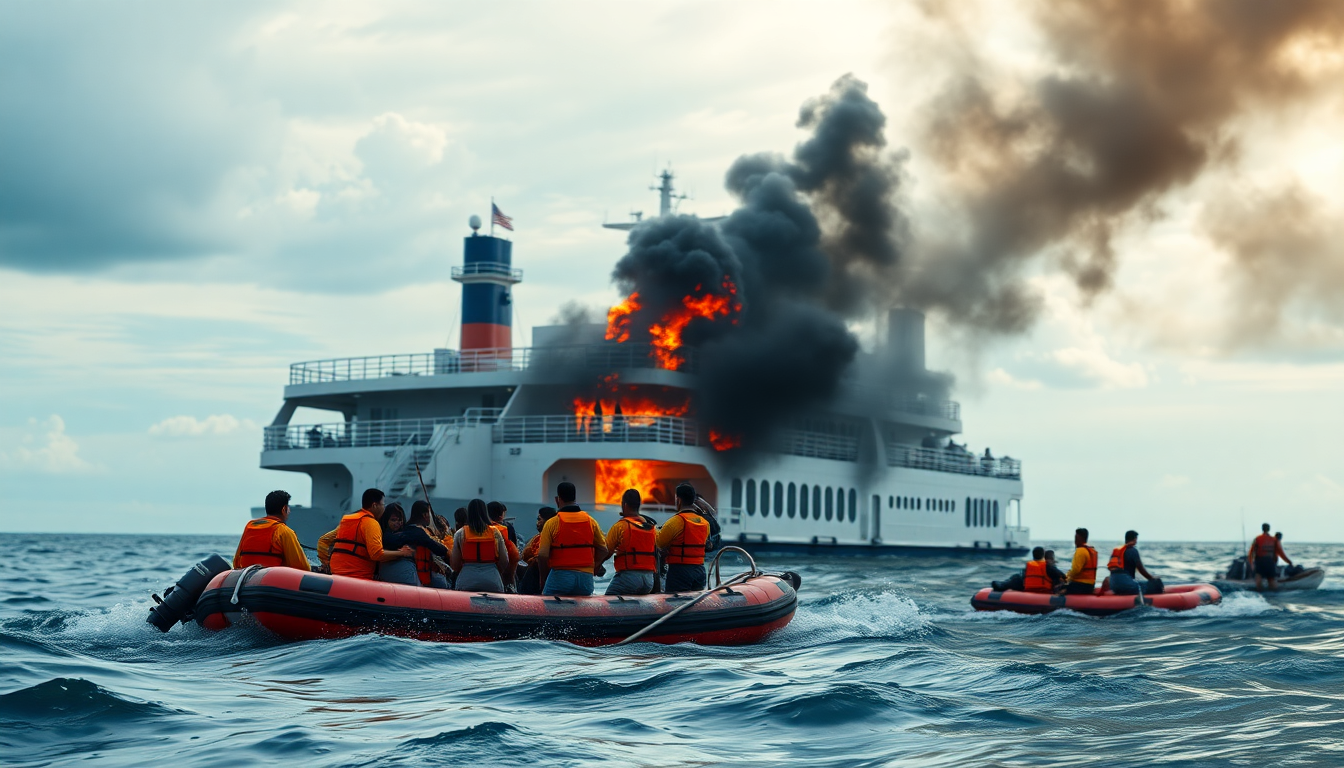Table of Contents
On a fateful Sunday afternoon, the Indonesian passenger ferry, the KM Barcelona V-A, was engulfed in flames while navigating the waters of North Sulawesi province. This harrowing incident quickly transformed into a dramatic rescue operation, ultimately saving 575 passengers. However, the tragedy was marked by the heart-wrenching loss of three lives, with two individuals still unaccounted for. It serves as a painful reminder of the dangers tied to ferry travel in Indonesia, an archipelago that heavily relies on maritime transportation.
Details of the Incident and Rescue Efforts
The fire broke out around midday during the ferry’s routine journey from Melonguane to Manado. According to First Adm. Franky Pasuna Sihombing, head of the Manado navy base, the flames originated from the stern and were extinguished within an hour. Interestingly, the ferry’s manifest initially listed only 280 passengers and 15 crew members—a discrepancy that isn’t uncommon in Indonesia’s transportation systems. How can a vessel hold so many more people than officially reported?
In swift response to the emergency, coast guard ships, six rescue vessels, and several inflatable boats were deployed. Local fishermen also played a pivotal role, rescuing survivors who were seen drifting in the choppy waters, many outfitted with life jackets. Eyewitnesses recounted the chaos, with terrified passengers leaping into the sea as smoke and flames billowed from the ferry. It’s a scene that no one should ever have to witness.
By Monday afternoon, rescuers confirmed that 575 individuals had been saved, including a two-month-old baby who was stabilized after inhaling seawater. Tragically, three lives were lost, one of whom was a pregnant woman. As search efforts continue for the two remaining passengers, it emphasizes the urgent need for thorough investigations into what went wrong.
Understanding the Broader Implications
This incident casts a glaring spotlight on the frequent maritime accidents in Indonesia, a country made up of over 17,000 islands where ferries are a primary mode of transport. With a ferry capacity of 600 people, the stark difference between the number of passengers on the manifest and those rescued raises serious concerns about safety protocols and enforcement within the maritime industry. How many more incidents like this will it take for real change to occur?
Recent history has seen a string of maritime disasters in the region, including a speedboat capsizing during a storm last July and a ferry sinking near Bali earlier that month, resulting in numerous casualties. These repeated tragedies underscore the urgent need for improved safety measures and regulations to protect passengers. It’s high time for the government to step up and prioritize safety.
As the investigation into the KM Barcelona V-A fire unfolds, authorities must tackle the systemic issues that contribute to such incidents. By ensuring that safety regulations are strictly enforced, they can work towards preventing future tragedies and safeguarding the lives of those who depend on these vessels for transportation. Isn’t it time for a change?
Future Outlook and Considerations
Looking ahead, Indonesian maritime authorities must take actionable steps to enhance safety within the ferry transport sector. Implementing stricter regulations regarding passenger manifests, conducting regular safety drills, and ensuring comprehensive vessel inspections could significantly reduce the likelihood of similar incidents happening in the future. What can we do to ensure that the lessons learned from this tragedy lead to real change?
As the nation grapples with the aftermath of this latest tragedy, the focus must shift toward long-term improvements that prioritize passenger safety. Both the community and the government need to advocate for accountability and reform, ensuring that maritime travel can be conducted with the highest safety standards. After all, every passenger’s life is precious.
In conclusion, the fire aboard the KM Barcelona V-A serves as a tragic reminder of the vulnerabilities present in Indonesia’s maritime travel system. With a dedicated commitment to enhancing safety measures, the nation can honor the lives lost by preventing future tragedies and protecting its passengers. Let’s hope this serves as a turning point in maritime safety.


